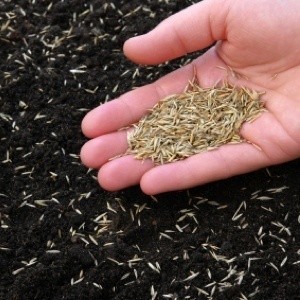
Sooner or later, even the healthiest and most well-maintained lawn will probably need some minor repairs. Whether it's caused by insects, disease, over-use, or just a bout of bad weather, if your lawn is suffering from thin spots and bare patches, spot seeding is a great way to repair and re-establish grass in small areas.
Early fall is often thought of as the preferred time for planting grass seed, because the conditions are best for getting grass off to a good start (warm soil, ample moisture, and fewer sprouting weeds). The best time to spot seed your lawn, however, is anytime your schedule (and the weather) allows you to. Just keep in mind that in extremely hot weather you'll need to really keep an eye on watering so the seed stays moist during germination. In the early spring, cool soil temperatures may delay germination and the soil may be too wet to be easily worked.
Patching works best in areas where the grass has completely died back. Use this technique to repair tire ruts along driveways, areas worn down by foot traffic or damaged by pets, or spots that have become bare as a results of insects or disease.
Prepare the seed bed. Use a shovel to strip the area of any existing grass and weeds. If necessary, add organic matter and a few inches of weed-free topsoil to bring the bare spot up to the level of the surrounding soil. Create a good seed bed by raking the soil until it's smooth and level.
Apply the seed. Use a seed type that is as close as possible to your existing grass. Sow the seeds thickly. This can be done using a drop spreader or by scattering the seed by hand. When you're done, most of the soil that was visible when you started should be covered by seeds. Remember, not all of the seeds will germinate so don't be afraid to lean toward excess. To help the new grass blend in better with your existing grass, scatter some extra seed beyond the perimeter of the area you're trying to improve.
Tamp and top-dress. To ensure good seed-to-soil contact, work the seeds into the soil by gently dragging a rake (tines inverted) across the top of the soil, tamping it lightly with your hand. Be careful not to compact the soil. Cover the seeds with a thin (1/4 inch) layer of topsoil or fine compost.
Water thoroughly. Dampen seeds daily until they germinate-twice daily during periods of extreme heat. After germination, your new grass should be given the equivalent of 1-inch of water per week. Water deeply rather than frequently to help establish deep roots. After about 6 weeks, you should be able to treat the area like an established lawn.
Overseeding is a technique that works best in areas where your lawn appears thin. Unlike patching, you won't be broadcasting the seed onto bare soil so this technique doesn't work well on lawns that contain heavy amounts of thatch.
Start by pulling out any existing weeds. To make sure the seeds come into contact with the soil, mow the existing grass as close to the ground as possible. Scratch up the surface of the bare soil with a metal garden rake, being careful not to cause damage to your existing grass. Apply seed (at the same rate recommended for new lawns), tamp lightly, and cover the seeds with a thin layer (1/4 inch) of fine compost or top soil. Water thoroughly and continue to keep the soil evenly moist until germination.
Allow new grass to grow to at least 1/3 taller than its normal height before mowing it for the first time. For most grass types, this translates to a height of at least 2 1/2 to 3 inches tall. The roots of young grasses are shallow and the blades soft and easily torn, so use sharp mower blades and be extra careful the first few times you mow. If you have a mulch setting on your mower, "grasscycle" the clippings back onto the young grass. The clippings will act like a fertilizer while helping the soil retain moisture.

About The Author: Ellen Brown is an environmental writer and photographer and the owner of Sustainable Media, an environmental media company that specializes in helping businesses and organizations promote eco-friendly products and services. Contact her on the web at http://www.sustainable-media.com
Add your voice! Click below to comment. ThriftyFun is powered by your wisdom!
I've had good luck adding peat moss on top to retain moisture and keep those pesky birds from eating the grass seed!
Add your voice! Click below to comment. ThriftyFun is powered by your wisdom!